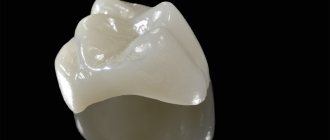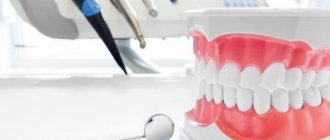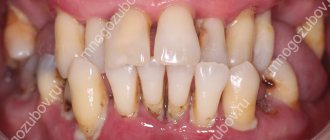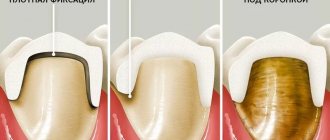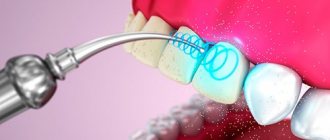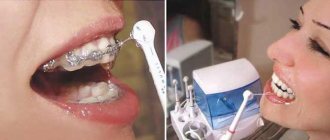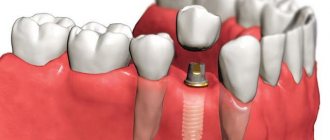Prosthetics
In clinics, doctors offer various options for replacing teeth. You can restore what you have lost using a variety of methods:
implantation of an implant, which is installed in place of a lost tooth; installation of crowns (this method is used if any part of the tooth or its root is preserved); production of a bridge prosthesis, which is attached to healthy teeth located next to the missing one.
When deciding on the method of prosthetics, the dentist always studies the clinical picture. If the tooth is present and pulpless, the doctor may install a crown. If it is removed, he will choose either implantation or a bridge. Implants are indicated if the teeth located to the right and left of the defect are not pulpless and healthy. To install a bridge, the dentist removes the pulp and grinds down the edges.
If a tooth is severely damaged or loose, the doctor can remove it and then replace it with a prosthetic.
So: what to do?
Option 1: indigenous in an adult
See a doctor immediately! This is what experts and people who have suffered from tooth loss and the consequences of this phenomenon recommend. We must leave the fear of visiting a dental clinic and the reluctance to sit in a doctor’s chair outside the door. And “surrender” to the mercy of medical specialists. It is not recommended to put teeth into place on your own and attach them to neighboring ones, and then continue to live carefree. Having inserted the fallen tooth back into its socket and fixed it, you should immediately seek help from a doctor.
If a tooth is lost, then there are methods of assistance such as dentures and implantation. In addition, existing gum diseases, caries, and even more so, periodontal disease and periodontitis should be treated, which is absolutely impossible without the qualified help of a dentist. Even if a filling just falls out, you should immediately consult a doctor, otherwise the appearance of irreversible processes and other troubles with your teeth and gums will be guaranteed.
Materials
Not many people are aware of the options for replacing teeth. Implantation differs from prosthetics using crowns only in the method of attaching the coronal area of the tooth. In the first case, the structure is attached to an implanted implant, which performs the function of a molar root. In the second, it is put on the remaining part of the tooth, previously strengthened with a pin and enlarged with the help of filling materials or a stump attachment.
The crowns in both the first and second versions are identical. They are made from different materials:
metal ceramics; metal; metal-free ceramics.
Prosthetics using implants
Today, implantation is the most effective method of restoring teeth. Implants can be installed for both partial and complete edentia.
The implant plays the role of a durable artificial root. It is implanted into bone tissue. The support necessary to put on the crown is attached to it. With proper care, the implant will serve the patient throughout his life. Replacements may require solely a crown.
The huge advantage of this method is that the bone tissue does not atrophy after tooth extraction. In modern dentistry, implantation can be performed in one operation - immediately after the removal of a dental unit, an implant is implanted in its place.
Steel Product
Now let’s begin to closely study the options for replacing teeth. Metal crowns with gold plating or polished metal colors are used in dentistry mainly for the reconstruction of chewing molars, which are not visible when opening the mouth. They are most often cast from a chromium-cobalt alloy. These crowns have the following advantages:
long service life (minimum 12 years); high reliability and strength; low cost; small degree of grinding of teeth (unlike pure ceramics or metal-ceramics), which increases their durability.
Metal ceramics
Dental prosthetics is a complex science that every specialist should study. Metal-ceramic crowns occupy an intermediate position between porcelain and iron in terms of strength, aesthetic qualities and price. They are made of several materials: a steel frame is placed inside, and a ceramic coating is placed on top. The frame gives the crown stability and strength, and the coating allows you to give the prosthesis a natural appearance.
Metal-ceramic crowns have the following advantages:
service life - 10 years or more; high reliability and durability; good aesthetics.
It should be noted that from an artistic point of view, these crowns are inferior to all-faience crowns. After all, there is an iron frame inside them, they are not completely transparent and this differs from real teeth. If a single metal-ceramic crown is installed on the front molars, the difference between it and other teeth will be noticeable. If the entire row of visible molars is made of this material, then they will look natural and beautiful.
Metal-ceramic crowns have the following disadvantages:
the tooth needs to be impressively ground on all sides, since the thickness of such a crown is too large; the molars have to be depulped (usually the frontal ones).
What can a lack of teeth in the mouth lead to?
Aesthetic side
The absence of one or more teeth can lead to consequences that are completely unexpected and very unpleasant...
From an aesthetic point of view, it's simply ugly. The appearance of a person who has lost one or more teeth almost changes dramatically. He looks older than his years; his cheeks and lips may become sunken, which obviously will not improve his appearance; well, if an incisor falls out, this will also affect his speech, which may become lisping and slurred.
In addition, a person who has lost one or more teeth for some reason will look unrespectable, not well-groomed and even sloppy, even if he is dressed in an expensive Gucci suit, a fashionable poncho from Calvin Klein and Testoni boots for seven hundred fifty euros.
What do the doctor's say?
From a medical point of view, the loss of teeth can ultimately lead to stomach and digestive diseases, since food will become less chewable, irritate the walls of the stomach, be poorly digested, and enter the esophagus insufficiently processed.
Among other things, the presence of an empty cavity in the mouth deprives the teeth adjacent to it of the opportunity to lean against each other, thereby maintaining stability. And it doesn’t matter whether a molar or a front tooth falls out, because both can become loose from lack of support. And if proper measures are not taken, the loss of new teeth will be inevitable. And their loss can lead, in turn, to the development of various pathologies of the oral cavity. There is only one conclusion: something needs to be done about the loss...
Hybrid prostheses
Sometimes dentists make dentures that consist of crowns made from different materials. This reduces the overall cost of prosthetics.
If the bridge includes both front and back teeth, then the first can be made of metal-ceramics, and the second from pure steel. Iron molars are no worse in strength and other indicators, and savings can be up to 30-40%.
Porcelain
Ceramic crowns are made from zirconium dioxide or porcelain. They do not have a steel frame and are made entirely from high-strength earthenware raw materials.
Only single crowns are made from porcelain, since this material is not suitable for bridges. These products can be manufactured in two ways: injection molding and layer-by-layer application. Crowns created using the first method are much stronger.
The porcelain product has the following advantages:
excellent aesthetics (it is almost impossible to distinguish it from natural teeth); resistance to various influences (porcelain does not deteriorate over time and does not darken).
Zirconium crowns consist of a frame made of zirconium dioxide and porcelain mass. The frame of the device is very durable. In addition, it allows the sun's rays to pass through, which improves the aesthetics of the crowns.
They have the following positive qualities:
durability and high strength; excellent aesthetic qualities; appearance remains unchanged for a long time.
Both types of ceramic crowns have the only drawback - their high price.
Basic techniques
The types of prosthetics used in modern dentistry differ in a number of design features, manufacturing materials and installation techniques.
A variety of techniques allows you to replace extracted teeth for any complexity of the clinical case, taking into account factors such as the cost of the procedure, the comfort and duration of use of the prosthesis, the material of manufacture and the method of fixation.
Temporary prosthetics
In most cases of prosthetics, a person has to wait some time for a prosthesis to be made for him or for implants to take root. The waiting period can last from a couple of weeks to several months (in the case of implantation).
In order for patients to maintain their usual lifestyle, avoid the development of psychological discomfort due to unattractive appearance, and restore basic functionality to the dental apparatus, the installation of temporary dentures is proposed.
Temporary prosthetic structures allow you to solve the following problems:
- Hide the resulting defect in the jaw row.
- Eliminate the unattractiveness of the problem unit after grinding it, and protect it from infection and injury.
- Restore the functionality of the dentofacial apparatus and provide adequate nutrition.
- Protect the jawbone from deformation and development of atrophy due to lack of load.
Such orthopedic products are divided into two groups:
- Conditionally removable. These are bridge-like structures that are secured to supporting elements using nylon hooks or loops. Typically used for the restoration of single defects in which one or two units are missing.
- Removable (otherwise immediate dentures). You can temporarily close defects of different sizes. They are fixed, like the previous version - on supports.
Nylon or soft plastic (acrylic) can be used to make temporary structures. The big advantage of these materials is their sufficient aesthetics, i.e. They imitate the color of the mucous membrane of the gum tissue and enamel coating quite well.
The average service life of such products is 2-3 years. In practice, there are many cases where, with careful treatment and care, temporary dentures served for a longer period.
Temporary prosthetic structures are characterized by the following undoubted advantages:
- complete restoration of the functionality and aesthetics of the jaw row during the manufacture of a permanent prosthesis;
- normalization of pronunciation and chewing ability;
- slowing down the loss of jaw bone volume;
- assistance in adaptation to a permanent structure;
- preventing displacement and deformation of rows;
- maintaining correct bite;
- protection of prepared elements from external irritants (destruction) and gums from damage;
- uniform distribution of chewing load to prevent damage to the remaining elements;
- ensuring natural facial expression;
- elimination of psychological discomfort.
The following characteristics are worth noting as disadvantages:
- quick erasing of materials;
- short-term operation;
- color change due to the ability of materials to actively absorb food dyes;
- insufficient hygiene due to the rapid formation of plaque;
- rubbing of the gum mucosa;
- risk of fasteners separating.
Let's figure out how long dental prosthetics takes, starting with diagnosis and ending with installation of the structure.
Come here if you are interested in how dental ceramics are made.
At this address https://zubovv.ru/protezirovanie/nesemnyie-p/osnovyi-pri-parodontoze.html we will find out whether dental prosthetics is possible for periodontal disease.
Permanent
Among the wide variety of permanent prosthetic structures, one of the following options can be used.
Clasp
This is a high-tech compact device representing a plate arch with artificial teeth. Installed on any fragment of the jaw row.
The system is held in place by clasps (hooks), telescopic crowns or clasps. Each type of fastener allows you to easily remove the structure for cleaning or maintenance.
The design has the following significant advantages:
- wide range of applications;
- comfort of wearing;
- no change in food perception;
- uniform distribution of chewing load;
- reliable and long-term operation;
- fast adaptation;
- no violation of diction;
- ease of maintenance;
- small parameters;
- high aesthetics (except for the model with clasps);
- minimal chance of breakdown.
Against the backdrop of a significant list of advantages of clasp dentures, several disadvantages stand out:
- support elements need to be processed;
- Some fasteners do not look aesthetically pleasing;
- high price;
- long production.
Important! These design flaws do not in any way affect the demand among patients.
Bridges
These are products consisting of several single crowns connected together, the outermost ones being fixed to previously prepared support units, and the central ones replacing the missing elements.
Devices are used to fill gaps in the jaw row.
There are several variations of bridges:
- Classic . Units adjacent to the defect site are used as supports. Recommended for recreating any group of teeth in the jaw row.
- Crownless ( Cbw ). They are held in place thanks to locking connections fixed in the channels of the supporting elements.
- Adhesive. They are fixed using special plates or tires that are glued to the supports. They are offered only for the restoration of the frontal group or incisors due to their insufficient strength.
Bridges are no less popular than clasp structures. Their demand among patients is explained by:
- ease of manufacture and fixation;
- convenient, long and comfortable to wear;
- low cost;
- possibility of full restoration of functionality;
- reliable fastening.
Flaws:
- increased load on supports;
- the need to grind (with the classic version of the prosthesis);
- insufficient strength of the adhesive bridge;
- development of bone tissue atrophy under the unused gum area.
Plate structures
These are the simplest removable prosthetic structures in terms of manufacturing and installation technology. They are a rigid base with tooth simulators, which is fixed to the gums by suction.
Products are recommended in the absence of fangs, molars or incisors.
If chewing units are preserved in the mouth, holes are made in the prosthesis, and then these teeth will serve as supports for attaching the entire prosthetic system.
They are made individually for each patient using an impression of the jaw rows, and can be installed at the first visit to an orthopedic dentist.
In addition to the individual approach to each clinical case and speed of production, among the advantages it is worth noting:
- cheapness;
- restoration of chewing function;
- ease of care;
- no contraindications for installation.
Among the general disadvantages it is necessary to highlight:
- lack of aesthetics (i.e. they look artificial);
- fragility (cannot withstand heavy and regular loads);
- short-term operation (no more than 3 years);
- discomfort when wearing and difficulty getting used to;
- deterioration in the perception of food taste;
- problems with pronunciation;
- increased salivation;
- impossibility of uniform load distribution.
Important! For a long time, plate dentures were practically the only way to restore teeth with complete edentia. But modern dentistry, thanks to the emergence of other (more modern) prosthetic designs, has practically abandoned their use.
In the video, a specialist will talk about removable prosthetics after tooth extraction.
Dentures
Now let's look at removable prosthetics. Insertable bridges are divided into several groups:
removable complete plate plastic dentures; removable partial dentures (plate plastic bridges and immediate dentures, clasp jaws, removable sectors of the dentition); conditionally removable bridges.
Plastic dentures are made from acrylic. They are in great demand in dentistry, as they can be used by people of all ages. Plastic structures are used in cases of complete or partial absence of teeth. They can be:
removable and non-removable; pressed and injection molded; temporary and permanent.
Stages of dental prosthetics
Dental prosthetics consists of several stages.
- Preparation. Includes consultation with a doctor, diagnosis, and treatment of dental diseases.
- Manufacturing of orthopedic structures in a dental laboratory (Stompraktika has its own laboratory equipped with the latest technology).
- Trying on the finished design and adjusting it (if necessary).
Molar reconstruction
What is a removable denture for one tooth? If your molar is destroyed or removed, your dentist will install a metal-ceramic crown. Unfortunately, sometimes this cannot be done for various reasons. The only solution in such a situation is a replacement prosthesis.
It may have an internal concave part, which is necessary in order to cover a damaged tooth. If hard tissue is completely absent, then a one-piece device is used.
A removable denture for one tooth can be attached in various ways. Depending on this, it can be of several types. A denture with clasps is the most famous type of such a system. It consists of a base, the molar itself and a pair of clasps that cover the natural teeth. The base and locks are made of plastic or nylon. Their texture and color are the same as natural gums, so the artificial tooth is quite difficult to notice.
A tooth fell out! What to do in this case?
Nowadays, tooth loss is a fairly common occurrence. Thousands of people face this problem every day. This phenomenon can be triggered by many things, such as eating solid food or getting hit in the face. Undoubtedly, a person who has lost a tooth (whether due to caries, periodontitis or injury) wants to restore it as soon as possible.
Section navigation:
What to do if you have lost a tooth? The best solution in this case would be to immediately visit a specialist. Only he can prescribe the correct dental treatment. A missing tooth is not only an aesthetic problem, but also a medical one. After all, if the necessary measures are not taken, the neighboring teeth will become loose, and their base will become inflamed. In addition, you can lose not only the tooth located opposite and deprived of natural support, but also all the others. Unfortunately, very often a careless attitude towards the loss of one tooth leads to serious consequences for the entire oral cavity.
Features of wearing and care
So, we have practically studied removable prosthetics. Just because a one-tooth denture is removable does not mean that it needs to be removed every night. Today, the patient can wear the structures for months without feeling any discomfort.
The device must be removed once a week for disinfection in a special solution. Teeth with such a prosthesis can be cleaned as usual, since it is not necessary to remove it. This nuance distinguishes the care of such devices from cleaning conventional bridges.
Implantation
Implantation is the most reliable and natural way to restore missing teeth. Usually only one crown is fixed per implant. If a bridge is installed, the structure becomes a support for it.
In practice, several techniques are used to install an artificial root. But their essence boils down to the implantation of a titanium rod into the jawbone, onto which an abutment and an artificial crown will later be attached.
In terms of aesthetic and functional characteristics, the implant is comparable to real teeth. Besides:
- there is no need to grind the teeth adjacent to the defect site;
- no problems with pronunciation;
- the course of many natural processes in the bone is normalized;
- facial features are not distorted.
Minuses:
- an impressive list of restrictions;
- duration of the process;
- high cost;
- age limit (only after 18 years).
Important! Considering that implants, with proper care and compliance with operating rules, can last 20-25 years without problems, the listed disadvantages can be considered conditional.
Installation of the implant into the hole
The essence of this technique comes down to installing an artificial root after tooth extraction, i.e. The implant insertion site is the expanded socket. The operation is recommended for prosthetics of the frontal area and takes place in one visit under local anesthesia.
Following implantation (on the same day), prosthetics are also performed - a temporary prosthesis is placed on the head of the rod protruding beyond the edge of the gum.
As soon as the osseointegration process is completed (and this is approximately 4-6 months), the temporary prosthetic structure is replaced permanently.
The main conditions under which simultaneous implantation is possible are:
- The patient's health is satisfactory.
- The presence of sufficient volume and good quality of bone and keratinized gum tissue.
- The presence of your own or artificial teeth next to the installed implant, which can protect it from loosening and take on most of the chewing load.
- Availability of sufficient implantation area.
- Absence of major risk factors that could worsen the outcome of the operation.
This approach to restoring the integrity of the rows makes it possible to restore both the aesthetics and functionality of the dentofacial apparatus in a short period of time.
At the same time, the risk of artificial root rejection, compared to the classical technique, increases many times over, since access to pathogenic microflora in the area of engraftment remains open, and the implant receives load on the very first day after surgery.
Single-stage implantation
The meaning of simultaneous (instant) implantation is to implant the structure in a short period of time after tooth extraction.
Further recovery can take place according to one of three scenarios:
- The gum tissue is sutured, a period of time is waited until it heals, and only then other manipulations are performed.
- After inserting the artificial root, the former is secured to form the desired shape of the gum. Prosthetics are carried out only after a while (i.e. after tissue healing).
- The installation of the prosthesis begins immediately after implantation.
The positive aspects of one-stage implantation are the short duration of treatment and recovery, minimal tissue trauma.
But it is worth noting an impressive list of contraindications, a high probability of rejection, as well as strict requirements for the condition and hygiene of the oral cavity.
With immediate load
The principle of the technique comes down to a very rapid restoration of the aesthetics and functionality of the dentofacial apparatus. The operation is minimally invasive (the structure is inserted through a puncture in the gum, no stitches are applied), it is performed without bone grafting, and the load on the artificial root can be applied almost immediately (the prosthesis is fixed after a couple of days).
To implant implants, not only spongy bone is used, but also deeper layers.
Implantation using the immediate loading protocol can be carried out using the following methods:
- "InstanTeeth". Recommended for recreating one dental element.
One-piece structures are used (when the screw is combined with an abutment), which can be loaded with a crown the day after surgery. The peculiarity of this technique is that the prosthesis is “removed from occlusion,” i.e. the height of the teeth adjacent to it is made slightly smaller, which ensures minimal participation in the chewing process. - "All-on-4". The prosthetic structure is secured to 4 implants, 2 of which are necessarily implanted at an angle in the lateral section.
The technique is approved for use if there is sufficient volume and quality of the jaw bone, or if there is slight atrophy. - "All-on-6". The technique is similar to the previous one, but here instead of 4, 6 one-piece implants are installed.
The increased number improves the fixation of the prosthesis and eliminates the need to adjust its position. The technique is indicated for use for any degree of bone atrophy. - "Basal Complex". The technique was developed to recreate complete dentition in cases of acute bone deficiency.
Artificial roots are installed in the dense layers of the jaw, and 8-12 units are implanted per row. The technique is indicated in the absence of two or more teeth in a row against the background of severe atrophy of the jaw bone or advanced periodontal disease.
The advantages of all methods are minimal trauma, short rehabilitation, minimal risk of complications, the ability to screw in implants at any angle, bypassing nerve endings and nasal sinuses.
The secret of the popularity of dental prosthetics in Heihe and the cost of specialist services.
In this publication, we will consider the components of a clasp prosthesis.
Here https://zubovv.ru/protezirovanie/nesemnyie-p/harakteristiki-payanyih-izgotovleniya.html we will discuss the pros and cons of soldered bridges.
